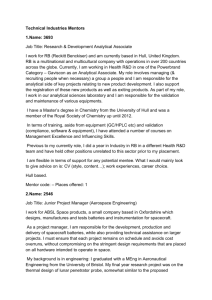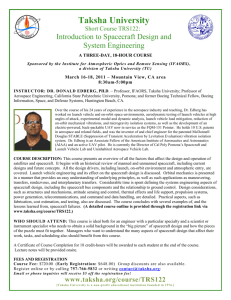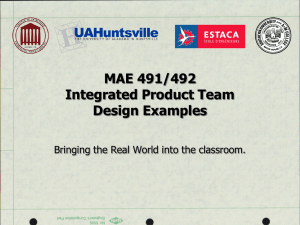Shackleton_FDR
advertisement
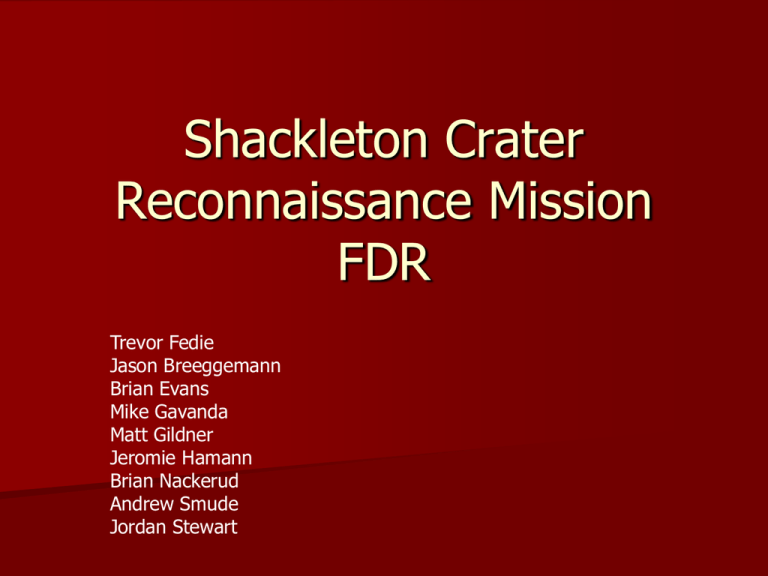
Shackleton Crater Reconnaissance Mission FDR Trevor Fedie Jason Breeggemann Brian Evans Mike Gavanda Matt Gildner Jeromie Hamann Brian Nackerud Andrew Smude Jordan Stewart Project Overview Image 5 km annular region around Shackleton Crater (at Moon’s south pole) – – – – 3 color imagery 10 cm resolution Image 80% of region in one month Transmit to Earth once per day Act as communication relay for lunar lander exploring interior of crater – Receive 2.5 Mbps S-band from lander – Transmit to Earth once per day Project Overview Baseline orbit of 30 x 216 km – Period approximately 120 minutes – 12 orbits each day Spacecraft must fit into Taurus Launch Vehicle – – – – Goal of 445 kg for everyday launch opportunities Must handle spin stabilized upper stage (60 rpm) Must interface with launch vehicle upper stage Must fit into launch vehicle envelope Major Tasks Develop an operational concept to support the mission objectives Determine the required data storage and return-link data rate Determine the antenna size and transmitter power Develop spacecraft design concept to support the mission Demonstrate that spacecraft design meets all mission requirements Expectations Spacecraft design will include – – – – – – – – – – Antenna size Data storage size Data link rates RF link calculations Mass budget Power budget Solar array size Battery size Pointing requirements Stability requirements Expectations Operational concept will describe end-to-end data flow from lander and from camera back to Earth – – – – Timeline Data rates Usage of on-board storage Contact times Students will identify major problems and risks associated with this mission concept Mission Profile Launch using Taurus Launch Vehicle Make burn for Earth-Moon transit De-spin Burn to enter Lunar orbit Begin imaging region around crater Finish imaging crater in about 14 days Lunar lander operations begin 4 months after launch and last for one year Camera Crater Imaging Strategy (Note: not to scale) Camera HiRISE (used on Mars Reconnaissance Orbiter) – Pushbroom TDI imager (4,048 pixels across swath) – 0.5 m aperture – 28 Gbits internal data storage – Internal LUT image compression – Mass: 65 kg – Average power: 60 W Storage Requirements 1.2 Gbits/photo Post compression 2 photos/pass 12 passes/day ______________ 28.8 Gbits/per day Considerations – – – – Limit broadcasts Safety margin Earth Weather Moments of “zero visibility” Data Storage – SSR P9 family 160 Gbits BOL Built-in FELICS 256 Mb SDRAM Computing & Data Storage – 3U Compact PCI PowerPC RAD750 Enhanced Power PCI Bridge Communications High Gain – Cassegrain Antenna D=.98m d=0.3m Power usage 100 W for broadcasting Double reflection – Smaller dish geometry – Wiring Earth Communications Transmit high resolution photos – – – – – – – Only one contact with White Sands per day About 28.8 Gbits a day in pictures Ka-band 26 GHz parabolic dish Data rate up to: 30 Mbps Power: 40 W Gain: 44 db White Sands receiving: 45 db/T http://www.grc.nasa.gov/WWW/RT/2005/PT/PTN-wilson.html Missions to the Moon Chang’e 1 (CNSA) SMART-1 (ESA) Chandrayaan-1 (ISRO, India) – X-band and S-band KAGUYA (JAXA) – S-band LRO (NASA) – KA-band – 100 Mbps data rate Link Analysis SNR=Pr/Noise Pr=EIRP*Gr/losses Examples of losses – Path loss (λ/4πR)2 – Atmospheric loss – Polarization loss N=k*T*B Link Analysis (Earth Communications) Data Rate Frequency Range Path Loss Power Gain Antenna Beam width EIRP Atmospheric Losses Receiver Gain Power Received System Noise SNR Link Margin Mbps GHz m W dB deg W db dB W W dB dB db 74.77 103.98 85.85 -232.10 16.02 45.17 30 26 3.84E+08 6.17E-24 40 45.17 0.86 7.23E+05 58.59 -5.2 -5.20 45 45.00 7.42E-15 -141.30 4.14E-16 -153.83 17.91 12.53 10.03 Link Analysis (Rover Communications) Parameters Data Rate Frequency Range Path Loss Transmitter Power Transmitter Gain EIRP Pointing loss Gain Power Received System Noise SNR Link Margin Mbps GHz m W dB W dB dB W W dB dB 2.5 2.3 3.00E+05 1.20E-15 5 10 27.5 -3 10 1.03E-13 2.07E-14 3.48 dB 63.98 93.62 46.99 -149.22 6.99 10.00 14.39 -3.00 10.00 -131.42 -136.84 5.42 2.92 Rover Communications Relay for rover in crater – – – – – – Required data rate of 2.5 Mbps Required S-band from rover 2.3 GHz Omni-directional transmitter Power: 5 W Gain: 10 db Rover Gain: 10 db L3 T&C transceiver MSX-765 Store data onboard satellite until downlink to White Sands ground Station http://www.l-3com.com/tw/telemetry_west/products/cxs_2000.htm Commands Receive commands from White Sands 128 Kbps data rate Save commands and relay to rover Required gain of 5 db Frequency of 2.1 GHz http://lro.gsfc.nasa.gov/gallery-hardware.html STK Model Earth – 4230 sec average daily window – Tracking Azimuth: 0.01617 deg/s Elevation: 0.0154 deg/s Moon – 12 communication windows ~5 min over crater ~9 Gbits of data a day ~5 minutes required to send to Earth STK Video Spacecraft Data Flow SSR Camera Transponders Flight Computer Antennas Spacecraft Data Flow Crater Imagery – Take 24 pictures per day (4048 x 60000 pixels) – Images initially 14 bits/pixel – Use look-up tables (LUT) to compress images to 8 bits/pixel before storage in camera memory – Use fast efficient and lossless image compression (FELICS) to compress images before storage in SSR (FELICS compression >1.6:1) – Transmit to White Sands once per day (~17 min contact window required) – Imaging operations complete within 14 days Spacecraft Data Flow Camera On-Board Memory Usage (1 July – 9 July 2009) Spacecraft Data Flow Camera On-Board Memory Usage (zoomed in) Spacecraft Data Flow Camera SSR Usage (1 July – 9 July 2009) Spacecraft Data Flow Rover Communications Relay – Rover operations begin 4-5 months after launch of first spacecraft – Contact with rover 12 times per day (~60 mins total) – Rover sends data at 2.5 Mbits/sec – Collect approximately 9 Gbits of data each day – Transmit to White Sands once per day (~5 min contact window required) – Rover operations complete within 17 months of launch of first spacecraft Spacecraft Data Flow Rover Data SSR Usage (14 Dec – 22 Dec 2009) Attitude Determination and Control Derived Requirements – Pointing stability (During an exposure time of 7.5e-3 sec) -Roll axis <0.343 arcsec -Pitch axis <0.343 arcsec -Yaw axis <13.4 arcmin – Pointing Accuracy with SF of 4 -Roll axis <2.5 arcmin -Pitch axis <8.6 arcmin -Yaw axis <2.7 arcmin – Maneuverability -3-axis control -Pointing reassignment as fast as 90 deg in 6 minutes Attitude Determination and Control SED 16 Autonomous Star Tracker by Sodern – Accuracy bias plus noise -Roll axis <108 arcsec -Pitch axis <36 arcsec -Yaw axis <36 arcsec – 10 Hz update – 25x25 deg field of view – Mass: 2.9 kg (with Baffle) – Average power: 10.7 W Attitude Determination and Control Scalable SIRU (gyro) by Northrop Grumman – Achieves Gyro Bias stability of 0.0003 deg/hr - Four HRGs (Hemispherical Resonator Gyro), with associated loop control/readout/thermal control electronics, and sensing along the octahedral-tetrad axes – Low noise – Mass: 7.1 kg – Average power: 38 W Attitude Determination and Control Momentum build up – Disturbance Torques - Gravity gradients - Solar pressure - Internal – Slewing Maneuvers - Once a day HR14 Constellation Series Reaction Wheels by Honeywell – Max Reaction Torque 0.2 N-m – Momentum Capacity 50 N-m-s – Mass: 8.5 kg Reaction Wheel Disturbances • Force from jitters of a single reaction wheel in a local frame Reaction Wheel Disturbances • Moment from jitters of a single reaction wheel in a local frame Disturbance Torques External – Solar ~1.68e-6 N-m – Gravity Gradient ~3.04e-7 N-m Internal – Deployables ~2.22e-5 N-m – At 50% max rpm of RWA’s (50 Hz) <0.76 N-m Maximum resulting displacement of a single pixel during camera exposure – Roll Axis <0.008 arcsec – Pitch Axis <0.008 arcsec – Yaw Axis <0.008 arsec Propulsion Trade Study Looked at Clementine, Ranger, Luna and Surveyor series Lunar orbiters Not much available info Studied fuel types, thrust ranges, and system configurations Keep it simple Propulsion System Rocket Motor: EADS Astrium S400-12 -MMH/MON-1 -420N thrust -0.135 kg/sec -Total V: 1021m/s Propulsion System Twelve 4N thrusters – MMH/MON-1 Fuel/Oxidizer – EADS Astrium S4 Two fuel tanks – Composite structure – 3600 psi rated – Lincoln Composites – 0.07 cubic meter Determination of Thermal Environment Moon surface temp Altitude and attitude Lunar view factor Intense reflected IR from lunar surface. Thus objects placement will important If thermo environment is compromised anywhere and active system will be used Dynamic Thermo Model Matlab-Simulink model Lumped sum approach (craft skin, propellant tank and electronic system Craft Skin is subject to radiation from space, sun, internal components and the moon System and Tank subject to conduction, internal power generation and radiation with the skin. Orbit assumed to have the craft always pointing at lunar surface. Craft skin Temp a function of alt, attitude, solar flux, (space/lunar) view factors, internal conduction and internal radiation System and tank temp controlled by PID loop Model analyzed under max shade and max sun light conditions Sketch of Thermodynamic Model Workspace Testing of Thermodynamic Model Adjust craft surface emissivity and absorptivity. Check against both models for zero heater condition equilibrium Varied internal surface properties for internal radiation heat transfer Used a steady state heating method to determine max and min heating watts needed Begin PID tuning of heating elements Recheck model Recheck craft properties & tolerances Finalize thermo model Results Surface exterior of 5.0 mil Aluminum FEP Teflon® Interior surface of black paint Electronics casing of anodized metal Tank heater of 60 watts electronic heater requires 300 watts Best to keep craft pointed at the lunar surface Since radiation is primary means of heat transfer, surface properties are the primary means of passive thermal control Radiation Environment Transient Particles: Protons and Heavy Ions of the Elements (GeV-TeV) Trapped Particles: Consists of Protons and Heavy Ions (100MeV) and Electrons (10MeV) Space Plasma: Major issue is surface charging of spacecraft (0.1MeV) Radiation Effects Total Ionizing Dose (TID): Degradation from Ionizing radiation, typically from primary protons and electrons. Causes Timing skews, leakage, and threshold shifts. Possible to use a shield to absorb lower energy electrons and protons. Non-Ionizing Energy Loss (NIEL): Non-ionizing displacement damage due to protons, electrons, and neutrons. Damage is permanent. Shielding may be effective based on the geometry and technology of the equipment. Single Event Effects (SEE): Due to ionization by a single charged particle. Typically high energy protons and neutrons. Due to high Energy, shielding is not effective. Radiation Environment of Shackleton Mission Energy (eV) Flux (cm -2) % Total Flux 2.00E+06 4.00E+06 6.00E+06 8.50E+06 1.25E+07 1.75E+07 2.25E+07 2.75E+07 >30MeV Total (eV/cm 2) % Total Energy 2.95E+11 1.18E+11 7.20E+10 7.00E+10 6.90E+10 4.20E+10 2.71E+10 1.89E+10 37.68% 15.07% 9.20% 8.94% 8.81% 5.36% 3.46% 2.41% 5.9E+17 4.72E+17 4.32E+17 5.95E+17 8.625E+17 7.35E+17 6.1E+17 5.2E+17 4.95% 3.96% 3.62% 4.99% 7.24% 6.17% 5.12% 4.36% 7.10E+10 9.07% 7.1E+18 59.56% 100% 1.19E+19 100% 7.83E+11 -Spacecraft Incident Solar Proton Fluences for 3 Solar Active Years. -Data from “Lunar Reconnaissance Orbiter Project” Goddard Space Flight Center Trade Study • • • • Material Thickness (cm) Al 0.25 Ti 0.15 Cu 0.08 W 0.04 Pb 0.06 Teflon 0.31 Comparison of shielding materials and corresponding thickness (cm). Only considered particles less than 30 MeV Averaged particle energy to 8.5 MeV/particle Initial fluence data from “Lunar Reconnaissance Orbiter Project” Goddard Space Flight Center Radiation Shielding Based on LRO requirements, the Shackleton Mission will be shielded to 10 krad total dosage rate. Utilize 0.25 cm Al shielding. Equipment with Linear Threshold Limit less than 75MeVcm2/mg for destructive events and 37 MeVcm2/mg for non-destructive events are adequately protected. Other equipment will need further analysis. Alternative/Additional Actions to Ensure Survivability of Spacecraft 1. Use of NMOS and PMOS, rather than CMOS increases radiation resistance at the expense of power consumption. 2. Transistor-Transistor Logic (TTL) is more resilient but uses more power. 3. Independent Processors with “voting” logic, and extra bits to allow error detection. 4. Spot-Shielding of specially sensitive equipment Power Requirements – Supply power to satellite – Support mission profile and requirements Major Design Drivers – Must fit inside Taurus launch vehicle – Provide adequate power – Reliable and easy to obtain Power Trade Studies – Solar Power vs. RTG vs. Nuclear Reactor – Silicon vs. GaAs solar cells – Body Mounted Array vs. Gimbaled Array Panels Power System Trade Study Power System Solar Panels RTG Nuclear Reactor Weight Low? High? High? Size Compact for launch, Compact for launch, large in use not large in use ? Orientation Issues Yes Yes Yes Heat Generation Low High High-Very High Optimal Temp. Yes No Yes Optimal Light Yes No No Radiation Degradation Yes Yes Yes Affected by other components Yes No ? Affects other components Some Yes Yes Require Batteries Yes Maybe not Maybe not Reliability Decent High Low-High Availability High Medium Low Ease of installation High Very low Low Power Level Med-High Med-High High-Very High Longevity 7-10 years 7-10 years 7-10+ years Power Budget System Max Power (W) Avg. Power (W) Voltage (V) SED 16 10 28 SED 16 10 28 Reaction Wheels 195 22 28 Reaction Wheels 195 22 28 Reaction Wheels 195 22 28 Reaction Wheels 195 22 28 38 28 60 28 37 28 SIRU (gyros) HiRISE Camera 125 SSR S-Band System 35 8.5 28 Ka-Band System 110 8.5 28 35 35 28 400 200 28 1580 495 Rocket Motor Heating Totals Mission Profile Power Requirements – Imaging: 560W – Transmitting to Earth: 597W – Transmitting to Rover: 522W – Receiving (from Earth or Rover): 495W – Orienting (Sun Side): 600W – Orienting (Dark Side): 800W Photovoltaic Cells Basic Triple Junction GaAs Solar Cells – 28.5% average efficiency – 26.6 square cm – Radiation Resistant – ~396 W/m^2 800 Watts Max Power 1020 Cells – 15 cells per 28V 4 15x8 cell panels and 4 15x9 cell panels Secondary Battery Lithium Polymer (Li-Po) – High Energy Density – Proven by use on other missions (MRO, LRO, etc.) 28 Volt Bus 9 3.4V Cells Power Regulation Peak Power Tracking – Active Power Regulation – Protects Sensitive Electronics (Camera) – Requires DC/DC Conversion to preserve efficiency – ~3kg in mass small penalty Power Solar Array Battery DC/DC Converter Peak Power Tracker Charge Controller 28V Bus Loads Discharge Controller Placement and Structure Components Satellite Structure - Functional Taurus Launch Vehicle Center of Gravity Side View Top View Δy = 2.2 cm Δz = 0.3 cm Mass Budget Component kg Component kg Camera 65 Star Tracker 5 Computer 8 Main Thruster 7 SSR (Memory) 12 Guiding Thrusters 4 Battery 9 Propellant Tanks 25 Power tracker 3 5 mm Al FEP Teflon® 3 Solar Array 9 Blankets 5 Transponder 5 Heaters 3 Ka-band Transmitter 4 Harness 10 High-Gain Antenna 4 Structure 90 Reaction Wheels 34 Propellant Mass 121 Gyro 7 Total Mass 433 Objective for everyday launch opportunity: 445 kg Mass Margin: 12 kg Major Problems and Risks Some redundancy built in – certain equipment failures could disable spacecraft Space debris impact could disable spacecraft Single event (radiation) effect could disable spacecraft Questions? Thanks to: David Everett – NASA GSFC Rajapandiyan Asaithambi Professor Flaten Professor Garrard Professor Hammer Also thanks to: Candice Hansen – NASA JPL Jim Bergstrom – Ball Aerospace

